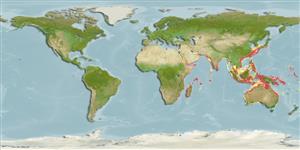>
Gobiiformes (Gobies) >
Gobiidae (Gobies) > Gobiinae
Etymology: Parachaeturichthys: Greek, para = the side of + Greek, chaite = hair + Greek, oura = tail + Greek, ichthys = fish (Ref. 45335).
More on author: Bleeker.
Environment: milieu / climate zone / depth range / distribution range
पारिस्थितिकी
समुद्री ड़िमरसल. Tropical
Indo-West Pacific: south to Natal, South Africa; India (Ref. 4833) and Japan (Ref. 559).
आकार / वज़न / Age
Maturity: Lm ? range ? - ? cm
Max length : 15.0 cm TL पुल्लिंग / अलिंग; (Ref. 2798)
पृष्ठीय रीढ़ (सम्पूर्ण) : 7; पृष्ठीय सौफट रेज़ (सम्पूर्ण) : 9 - 11; गुदा कांटा: 1; ऐनल सौफट रेज़: 9 - 10. Body greenish; fins dark; upper caudal fin base with a large black spot surrounded by yellow (Ref. 2798).
Parachaeturichthys spp. Inhabit deep water (Ref. 42915). Rarely enters estuaries (Ref. 4833). Captured by trawls over mud bottom (Ref. 11441). Found to contain tetrodotoxin (TTX) and anhydrotetrodotoxin (anh-TTX) which causes paralytic food poisoning (Ref. 54777).
Life cycle and mating behavior
परिपक्व अवधि | पुनरुत्पत्ति | मछलीऔ का अंडे देना | अंडे | Fecundity | लार्वा
Masuda, H., K. Amaoka, C. Araga, T. Uyeno and T. Yoshino, 1984. The fishes of the Japanese Archipelago. Vol. 1. Tokai University Press, Tokyo, Japan. 437 p. (text). (Ref. 559)
IUCN Red List Status (Ref. 130435: Version 2024-2)
Threat to humans
Poisonous to eat (Ref. 54777)
Human uses
मात्स्यिकी: कोई रुचि बग़ैर
साधन
Special reports
Download XML
इंटरनेट स्रोत
Estimates based on models
Preferred temperature (Ref.
123201): 22.4 - 28.1, mean 26.5 °C (based on 338 cells).
Phylogenetic diversity index (Ref.
82804): PD
50 = 0.7500 [Uniqueness, from 0.5 = low to 2.0 = high].
Bayesian length-weight: a=0.00891 (0.00538 - 0.01477), b=2.92 (2.78 - 3.06), in cm total length, based on LWR estimates for this species & (Sub)family-body (Ref.
93245).
Trophic level (Ref.
69278): 3.1 ±0.3 se; based on diet studies.
लौटाव (Ref.
120179): ऊंचा, न्यूनतम जनसंख्या दुगनी समय अवलागत 15 महीने। (Preliminary K or Fecundity.).
Fishing Vulnerability (Ref.
59153): Low vulnerability (10 of 100).
